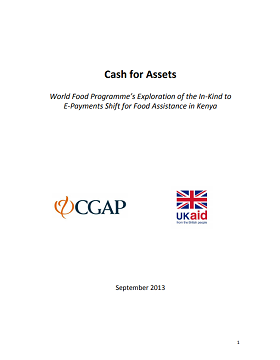Shifting Food Assistance in Kenya to E-Payments
The shift away from in-kind aid as the preferred mechanism for humanitarian assistance has contributed to the rise of cash transfers in Kenya. In 2008, the World Food Programme (WFP) for the first time shifted strategically from a food aid to a food assistance strategy, recognizing new and diverse ways in which the organization could address global hunger. Already looking for fertile ground for innovation, WFP Kenya decided to explore the possibilities for new modalities in delivering food assistance by launching an Innovations Team and experimenting with modifications of one already established program, Food for Assets (FFA). In 2010, WFP Kenya launched the Cash for Assets (CFA) pilot.
Kenya has become synonymous with innovation in financial inclusion beyond the branch, which has fueled increasing investment in new financial products, services, and delivery channels aimed at low-income and disadvantaged populations. WFP Kenya’s CFA took root within this context of innovation in financial services.
But financial services have grown unevenly in Kenya, with more growth in branches and agency banking taking place in population-dense areas such as Nairobi and Mombasa than in the arid and semi-arid lands in the north and east of the country, which have low connectivity and poorer and more widespread populations.
This case study discusses the program elements of the World Food Programme’s Cash for Assets pilot, as well as the design and implementation process, the experiences of stakeholders, how the pilot impacted recipients’ lives, and challenges the pilot faced.



